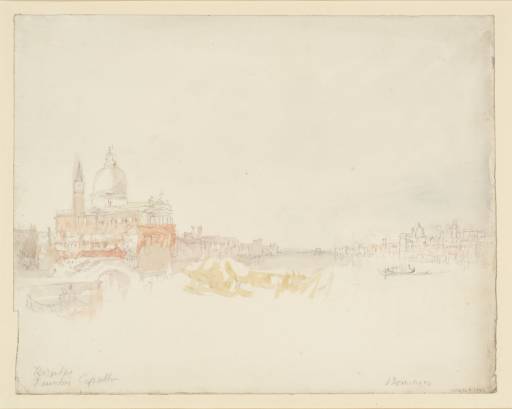Joseph Mallord William Turner The Redentore, Venice, with the Canale della Giudecca to its West 1840
Joseph Mallord William Turner,
The Redentore, Venice, with the Canale della Giudecca to its West
1840
Joseph Mallord William Turner 1775–1851
The Redentore, Venice, with the Canale della Giudecca to its West 1840
D32146
Turner Bequest CCCXVI 9
Turner Bequest CCCXVI 9
Pencil and watercolour on white wove paper, 244 x 310 mm
Inscribed by Turner in pencil ‘Redentore | [?Ruintore] Capuchin’ bottom left and ‘S Dominico’ bottom right
Blind-stamped with Turner Bequest monogram towards bottom right
Inscribed by John Ruskin in blue ink ‘1542’ bottom right
Stamped in black ‘CCCXVI 9’ bottom right
Inscribed by Turner in pencil ‘Redentore | [?Ruintore] Capuchin’ bottom left and ‘S Dominico’ bottom right
Blind-stamped with Turner Bequest monogram towards bottom right
Inscribed by John Ruskin in blue ink ‘1542’ bottom right
Stamped in black ‘CCCXVI 9’ bottom right
Accepted by the nation as part of the Turner Bequest 1856
Exhibition history
1934
Display of Watercolours from the Turner Bequest, Tate Gallery, London, March 1934–May 1937 (no catalogue, but frame no.II:22).
References
1909
A.J. Finberg, A Complete Inventory of the Drawings of the Turner Bequest, London 1909, vol.II, p.1018, CCCXVI 9, as ‘The Giudecca, with the “Redentore” and “S. Domenico.”’.
1930
A.J. Finberg, In Venice with Turner, London 1930, p.173, as ‘On the Giudecca looking towards Fusina’, 1840.
1985
Cecilia Powell, ‘Turner’s Venice’, Turner Society News, no.38, November 1985, p.8.
1840
Lindsay Stainton, Turner’s Venice, London 1985, p.58 no.61, as ‘On the Giudecca looking towards Fusina’, ?1840, pl.61 (colour).
2003
Ian Warrell in Warrell, David Laven, Jan Morris and others, Turner and Venice, exhibition catalogue, Tate Britain, London 2003, pp.183, 259, fig.202 (colour), as ‘The Redentore and Western Parts of the Giudecca Canal’, 1840.
The view is west-north-west along the Canale della Giudecca from between the Redentore and Zitelle churches (the latter being some way behind the viewer), off the Fondamenta della Croce. The Redentore is the most prominent building, seen to the south-west on the left beyond the bridge over the Rio della Croce, while the dome of the Gesuati is the most distinctive feature in the distance on the opposite side. The viewpoint, south of Santa Maria della Salute, is much the same as for two contemporary watercolour views to the north, ranging from the Salute to San Giorgio Maggiore, also included in this subsection (Tate D32139, D32145; Turner Bequest CCCXVI 2, 8).
Finberg later annotated his 1909 Inventory entry (‘The Giudecca, with the “Redentore” and “S. Domenico.”’): ‘looking twds Fusina, raised bridge near Redentore. The ch. opposite the Redentore (on the Zattere) is probably the Gesuati (S. Maria del Rosario) – it was built by the Dominicans who succeeded the Gesuati after 1688’.1 The Turner scholar C.F. Bell concurred, crossing out ‘S. Domenico’ in his copy and noting: ‘actually the Gesuati’.2 Lindsay Stainton later read Turner’s inscriptions, which ‘give the drawing the character of a page from one of the sketchbooks’, as ‘Redentore Ruintore [?] Capella S. Domenico’, inferring that the latter part ‘must be a reference’ to the Gesuati (under which it appears), as ‘the order of the Poveri Gesuati merged with the Dominicans in 1668.’3
Cecilia Powell has commented: ‘the third word ... seems clearly, I think, to be Capuchin rather than Capella: Turner was noting the fact that the [Capuchin] Franciscans [of the Redentore] and the Dominicans looked across the Giudecca canal at each others’ churches!’4 Turner’s second word, looking like ‘Ruintore’, remains elusive, although it may simply have been a garbled first attempt at ‘Redentore’, as written above it.
Technical notes:
This is one of numerous 1840 Venice works Ian Warrell has noted as on sheets of ‘white paper produced [under the name] Charles Ansell,1 each measuring around 24 x 30 cm, several watermarked with the date “1828”’:2 Tate D32138–D32139, D32141–D32143, D32145–D32147, D32154–D32163, D32167–D32168, D32170–D32177, D35980, D36190 (Turner Bequest CCCXVI 1, 2, 4–6, 8–10, 17–26, 30, 31, 33–40, CCCLXIV 137, 332). Warrell has also observed that The Doge’s Palace and Piazzetta, Venice (National Gallery of Ireland, Dublin)3 and Venice: The New Moon (currently untraced)4 ‘may belong to this group’.5
Albeit Peter Bower, Turner’s Later Papers: A Study of the Manufacture, Selection and Use of his Drawing Papers 1820–1851, exhibition catalogue, Tate Gallery, London 1999, p.81, notes that the Muggeridge family had taken over after 1820, still using the ‘C Ansell’ watermark.
Verso:
Blank; inscribed in pencil ‘30’ towards top right; stamped in black ‘CCCXVI – 9’ over Turner Bequest monogram below centre; inscribed in pencil ‘D32146’ bottom right.
Matthew Imms
July 2018
How to cite
Matthew Imms, ‘The Redentore, Venice, with the Canale della Giudecca to its West 1840 by Joseph Mallord William Turner’, catalogue entry, July 2018, in David Blayney Brown (ed.), J.M.W. Turner: Sketchbooks, Drawings and Watercolours, Tate Research Publication, December 2019, https://www

